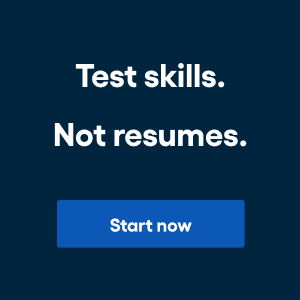Screening is a popular topic in the world of recruiting. From phone screens and social media screening to resume reviews and skills tests, recruiting teams are desperate to find effective screening methods that help them make the right hire.
[Read more: 7 Methods For Screening Candidates To Hire Better]
When we talk about screening, however, we’re usually talking about screening out. There’s a significant difference between screening in vs screening out applicants, and shifting from one approach to the other can help improve diversity hiring, lower recruiting costs, and even improve key metrics like time-to-fill and time to hire.
Here’s how to understand the difference between screening in vs screening out, and why one option is better than the other.
What is “screening out”?
Screening out refers to eliminating candidates because their background doesn’t fit a distinct set of criteria.
Screening out has its time and place: screening out candidates who are entirely unqualified, or spam, makes sense. But, screening out can quickly become an exercise in looking for reasons not to hire someone.
This leads recruiters to miss great candidates.
Pros of “screening out”
There are two main instances in which screening out makes sense.
The first is during a search for a niche, highly technical position.
When there are firm, non-negotiable requirements for a job, such as a CPA accreditation or teaching certification, screening out can help eliminate those who are entirely unqualified.
An ATS or other screening technology can filter out applications without these specific benchmarks. However, there’s a key difference between screening out someone who doesn’t have a necessary license and screening out someone who doesn’t have a certain degree or level of education.
The second instance in which you would screen someone out is if they aren’t able to meet the baseline requirements.
For instance, if the work would put the candidate’s safety at risk, they should be disqualified from the process. Likewise, if you’re requiring someone to work in a specific time zone, and the candidate is remote, that’s another reason to screen someone out.
Be careful that your “screening out” qualifiers aren’t discriminatory in any way.
In some cases, you might use the screening out option is during a high-volume hiring event. If you’re casting a wide net, there’s a chance you’ll get spam resumes or completely unqualified individuals who haven’t read the job description.
Use screening out to filter out any resumes that may have bypassed your spam filter accidentally.
Cons of “screening out”
Too often, recruiters use the wrong “metrics” to screen someone out. There’s a difference between not having a CPA license (which is an industry requirement) and not having an undergraduate degree in accounting from an Ivy League school.
[Read more: How To Avoid The 12 Kinds Of Hiring Bias In Your Recruitment Process]
Unconscious biases can cause recruiters to take shortcuts, using criteria such as gender, ethnicity, or some other factor that’s irrelevant to the job description to screen candidates. Hiring biases can not only prevent recruiters from finding the best candidates, but they can also stifle innovation, productivity, and employee engagement that stems from diverse and inclusive hiring practices.
Luckily, there’s an alternative to screening candidates out.
What is “screening in”?
Screening in is a more inclusive approach to hiring that considers candidates who may bring experience, enthusiasm, and energy to a team — despite not fitting all the criteria a recruiter had imagined when designing the job description.
The screening in process allows candidates to show their skills or to relay more information about them, providing context to their application that’s often erased in a two-dimensional resume or cover letter.
Screening in requires using a skill assessment, screening interview, or some other form of pre-employment testing to ascertain whether a candidate is truly qualified. “Recruiters should look for candidates that show a promising growth trajectory,” Michelle Armer, chief people officer at CareerBuilder told HR Dive.
Pros of “screening in”
Today’s job market is tight. There are millions of open jobs and nowhere near enough applicants to fill those openings. And, the pandemic has changed employee expectations of what they want in a company. This makes the talent market more competitive than ever.
Companies that shift to a screening in approach often benefit from finding “hidden gems” — candidates who may not have the traditional background, perfect credentials, or “right” education, but are perfectly well-qualified and capable of doing the job.
Screening in also enables recruiters to put their commitment to diverse hiring into action. There are tons of reasons why someone might have a nontraditional resume.
A parent, for instance, may have taken time out of the workforce to raise a family — resulting in a resume gap. The screening out process would immediately eliminate that person from the next round, causing the company to potentially miss out on a great addition to the team.
Cons of “screening in”
The potential downside of screening candidates in is that recruiters may end up with a long list of candidates to bring through the hiring process. Screening each candidate in is meant to give individuals the space to show more than just a resume and cover letter. As a result, hiring teams should be prepared to dedicate more time and resources to the screening process.
That being said, not all screening in techniques need to be resource-intensive. Some can actually be faster — and more effective — than a manual resume review.
How to reorganize your recruitment funnel to foster “screening in”
Skill tests are one of the most useful and fastest ways to screen candidates into the hiring process. According to Harvard Business Review, when utilized early in the hiring process, skill assessments can “efficiently weed out the least-suitable applicants, leaving a smaller, better-qualified pool to undergo the more costly personalized aspects of the process”.
Screening in is the philosophy behind Vervoe’s skill assessments. Our algorithm scores candidates using a multi-layered approach, ranking participants based on how well they perform, rather than filtering them out if they don’t achieve a certain benchmark. Top candidates easily shine, but no one misses out on being considered for the next round.
And, Vervoe’s AI does the majority of the work for recruiting teams. Our machine learning algorithms automatically grade and rank participants, allowing recruiters can speed through the screening process without cutting corners.
Candidates appreciate the opportunity to show their skills, too. Skill assessments mimic what a day on the job would entail. If a candidate recognizes the tasks are outside their skill set, they can decline to finish the assessment and let the recruiter know this isn’t the right fit.
Candidates appreciate the opportunity to avoid signing on for work they can’t accomplish or to take on a role that doesn’t match their career goals. Effectively, they can screen themselves out — producing a better result for everyone.
Learn how G4S successfully transitioned from “screening out” to screening candidates in.




















